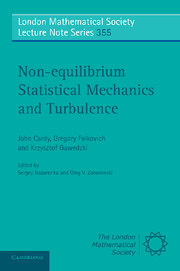2 - Krzysztof Gawędzki. Soluble models of turbulent transport
Published online by Cambridge University Press: 05 June 2012
Summary
Introduction
Transport of matter, pollution or chemical and biological agents by turbulent flows is an important phenomenon with multiple applications from cosmology and astrophysics to meteorology, environmental studies, biology, chemistry and engineering. This is a series of lecture notes reviewing some aspects of the theoretical work on simple models of turbulent transport done over the last decade and partly described already, often with much more details, in [Fal01]. Other approaches to modeling turbulent transport, with the stress on turbulent diffusion, may be found in the review [Maj99]. More practical issues related to the influence of turbulence on the chemical or biological activity were addressed in [Tel05] from somewhat similar point of view.
The aim of simple models of turbulent transport that we shall discuss here is to explain or discover general phenomena and robust behaviors rather than to provide a detailed quantitative description. We shall study exclusively the passive transport approximation which is relevant for small concentrations of transported matter so that its back-reaction on the flow itself may be ignored. From the mathematical point of view, passive transport may be considered as a problem in random dynamical systems. Some of the techniques developed over years in the dynamical systems theory are indeed useful in analyzing transport phenomena, especially for flows with moderate Reynolds numbers.
- Type
- Chapter
- Information
- Non-equilibrium Statistical Mechanics and Turbulence , pp. 44 - 107Publisher: Cambridge University PressPrint publication year: 2008
- 9
- Cited by

